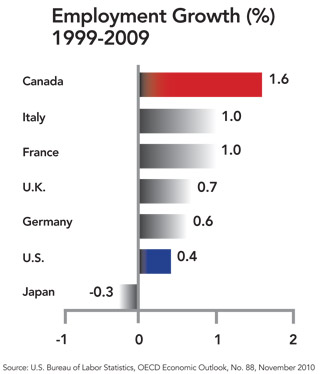





Still, a great education does not guarantee that a candidate will be perfectly suited for the latest jobs in today's ever-changing technological environment. That's why ongoing training and continuing education are so important. "One thing is clear to all of us: Our prosperity in the coming decades will depend on more Canadians having the skills needed in the labor market that post-secondary education provides," said Diane Finley, Canada's Minister of Human Resources and Skills Development, speaking to community college leaders.
Numerous and diverse programs across Canada ensure that the work force remains ready to meet the evolving needs of the business community. Take a look at Ontario. Second Career, a financial assistance program, helps laid-off workers go back to school so they can retrain for new careers in high-demand sectors. In northern Ontario alone, about 3,300 people have taken advantage of the program since it launched in 2008, collecting the cost of tuition and books along with help with living expenses and other career-change costs. So far, three-quarters of the participants have settled into new careers within a year of completing training.
Across the country in Salmon Arm, British Columbia, a million-dollar expansion of the trades training facility at Okanagan College is providing skills education opportunities for more students. "We know that skilled trades people will be in high demand in the coming years," says George Abbott, Minister of Education for British Columbia. The Okanagan College trades facility in Salmon Arm provides various levels of plumbing, electrical, residential construction, welding, and carpentry training.
To the east, the Atlantic Canada Opportunities Agency's Business Development Program is creating skills development opportunities in Moncton, New Brunswick. That's where Tech South East offers seminars and development opportunities in information technology and health and life science. The goal is to make local industry more competitive domestically and globally.

New Skills in Tough Times
Skills development is critical no
matter what shape the economy is in,
but it takes on increased urgency when
times are tough and careers change
under circumstances that are sometimes
involuntary. When the recession
took hold, Canada reinforced its training
programs.
A federal Economic Action Plan adopted in 2009 built on the existing Apprenticeship Incentive Grant program by adding an Apprenticeship Completion Grant program to encourage people to complete their apprenticeship training. Some 35,000 Apprenticeship Completion Grants have been issued, Finley reported late last year, along with more than 177,000 Apprenticeship Incentive Grants. The Apprenticeship Incentive Grants are worth up to $1,000 per year or training level, while the Apprenticeship Completion Grants provide $2,000 to those who have completed their training and become a certified journeyperson.
"There are many success stories as a result of these grants," Finley says. There's the woodworking hobbyist from Alberta who landed an Apprenticeship Completion Grant and trained at the Southern Alberta Institute of Technology to become a certified cabinetmaker. And the carpenter from the Northwest Territories who used his Apprenticeship Completion Grant funds to buy tools needed for his trade.
Apprenticeships are popular training options across Canada and continue to grow. In Ontario, more than 120,000 people are currently involved in apprenticeship training. That's nearly double from the level a decade ago, and new areas of apprenticeship are added as the need arises. A new program launched in January for residential sheet metal installers, and existing programs range from computer programmers and die designers, to call center agents and power technicians specializing in the entertainment industry.
Meanwhile, Canada's Employment Insurance program has a training component that received a billiondollar infusion during the recession to help recipients prepare for new opportunities. Another half-billion dollars were targeted to Canadians ineligible for Employment Insurance who might still need training to meet the changing needs of employers. The funds flow into the provinces and territories to support local needs and programs such as the Second Career initiative.

The Digital Future
The digital economy moves at a dizzying pace everywhere,
creating opportunities and challenges for forward-
thinking businesses. According to Finley, "A strong
digital economy will be the backbone of Canada's future
prosperity." Last November, Finley spoke at a conference
on developing a national digital strategy.
"Canadians in all walks of life need to have the skill sets to be able to access, use, and interpret digital information," she said there. "As technology evolves, it will be harder and harder to participate in the labor market and society unless you have digital skills."
The challenge for all nations is to find workers with up-to-the-minute skills. Canadian officials have spotlighted that challenge by acknowledging that their nation is not immune to the problem, but vowing to keep ahead of it. "Over 40 percent of the work force currently lacks the basic literacy and digital skills that are needed to thrive in the digital economy," Finley says. The solution expands partnerships between the education, business, labor, and governmental sectors to ensure adequate training opportunities for all who need them.
Industry Canada is leading the development of a digital strategy, Finley says, along with other entities including her department, Human Resources and Skills Development Canada. The agency works to ensure that digital skills are among the critical areas addressed by its Office of Literacy and Essential Skills. The office's Canadian Virtual College Consortium is developing online learning material for essential skills and including digital skills training in programs for young and old workers alike, along with Aboriginal people and the homeless.
Skills Development Partnerships
It makes sense for skills development to take place at
community colleges and other higher education institutions,
as well as through the work of agencies that interact
with workers transitioning between careers. But
Canada has found partners in less obvious places, too,
such as the YMCA and YWCA.
Canada's federal Economic Action Plan included a one-time grant of $15 million to the YMCA and YWCA to develop internships for 15- to 30-year-olds in need of work. The idea was to place them in not-forprofit and community service organizations where they could develop skills needed for future employment.
The YMCA/YWCA program aimed to get interns working on environmentally-focused projects. Dan Hendry was the first intern in the Youth Eco Internship Program at the Kingston Sustainability Centre in Ontario. He worked to further sustainable actions and boost community awareness in areas such as water, energy, food, and waste. "Through this position, I have been able to gain solid skills," Hendry says. "I'm convinced that my experience here will enhance my chances of finding work in my field in the Kingston area."
Whatever the industry, it's clear that Canada's thorough and strategic investments in one of its most valuable assets — its people — are already strengthening its work force now and for years to come.